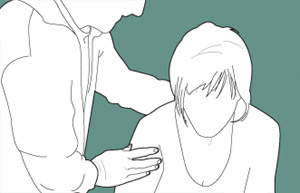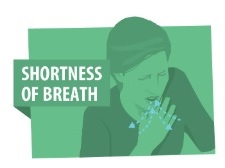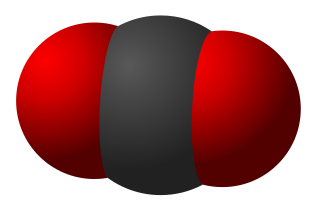Related Research Articles

Panic attacks are sudden periods of intense fear and discomfort that may include palpitations, sweating, chest pain or chest discomfort, shortness of breath, trembling, dizziness, numbness, confusion, or a feeling of impending doom or of losing control. Typically, symptoms reach a peak within ten minutes of onset, and last for roughly 30 minutes, but the duration can vary from seconds to hours. Although they can be extremely frightening and distressing, panic attacks themselves are not physically dangerous.
A bronchodilator or broncholytic is a substance that dilates the bronchi and bronchioles, decreasing resistance in the respiratory airway and increasing airflow to the lungs. Bronchodilators may be originating naturally within the body, or they may be medications administered for the treatment of breathing difficulties, usually in the form of inhalers. They are most useful in obstructive lung diseases, of which asthma and chronic obstructive pulmonary disease are the most common conditions. Although this remains somewhat controversial, they might be useful in bronchiolitis and bronchiectasis. They are often prescribed but of unproven significance in restrictive lung diseases.

Respiratory failure results from inadequate gas exchange by the respiratory system, meaning that the arterial oxygen, carbon dioxide, or both cannot be kept at normal levels. A drop in the oxygen carried in the blood is known as hypoxemia; a rise in arterial carbon dioxide levels is called hypercapnia. Respiratory failure is classified as either Type 1 or Type 2, based on whether there is a high carbon dioxide level, and can be acute or chronic. In clinical trials, the definition of respiratory failure usually includes increased respiratory rate, abnormal blood gases, and evidence of increased work of breathing. Respiratory failure causes an altered mental status due to ischemia in the brain.

A cough is a sudden expulsion of air through the large breathing passages which can help clear them of fluids, irritants, foreign particles and microbes. As a protective reflex, coughing can be repetitive with the cough reflex following three phases: an inhalation, a forced exhalation against a closed glottis, and a violent release of air from the lungs following opening of the glottis, usually accompanied by a distinctive sound.

Shortness of breath (SOB), also medically known as dyspnea or dyspnoea, is an uncomfortable feeling of not being able to breathe well enough. The American Thoracic Society defines it as "a subjective experience of breathing discomfort that consists of qualitatively distinct sensations that vary in intensity", and recommends evaluating dyspnea by assessing the intensity of its distinct sensations, the degree of distress and discomfort involved, and its burden or impact on the patient's activities of daily living. Distinct sensations include effort/work to breathe, chest tightness or pain, and "air hunger". The tripod position is often assumed to be a sign.
Hyperventilation is irregular breathing that occurs when the rate or tidal volume of breathing eliminates more carbon dioxide than the body can produce. This leads to hypocapnia, a reduced concentration of carbon dioxide dissolved in the blood. The body normally attempts to compensate for this homeostatically, but if this fails or is overridden, the blood pH will rise, leading to respiratory alkalosis. The symptoms of respiratory alkalosis include dizziness, tingling in the lips, hands, or feet, headache, weakness, fainting, and seizures. In extreme cases, it may cause carpopedal spasms, a flapping and contraction of the hands and feet.
Hypoventilation occurs when ventilation is inadequate to perform needed respiratory gas exchange. By definition it causes an increased concentration of carbon dioxide (hypercapnia) and respiratory acidosis. Hypoventilation is not synonymous with respiratory arrest, in which breathing ceases entirely and death occurs within minutes due to hypoxia and leads rapidly into complete anoxia, although both are medical emergencies. Hypoventilation can be considered a precursor to hypoxia and its lethality is attributed to hypoxia with carbon dioxide toxicity.

Hypercapnia (from the Greek hyper = "above" or "too much" and kapnos = "smoke"), also known as hypercarbia and CO2 retention, is a condition of abnormally elevated carbon dioxide (CO2) levels in the blood. Carbon dioxide is a gaseous product of the body's metabolism and is normally expelled through the lungs. Carbon dioxide may accumulate in any condition that causes hypoventilation, a reduction of alveolar ventilation (the clearance of air from the small sacs of the lung where gas exchange takes place) as well as resulting from inhalation of CO2. Inability of the lungs to clear carbon dioxide, or inhalation of elevated levels of CO2, leads to respiratory acidosis. Eventually the body compensates for the raised acidity by retaining alkali in the kidneys, a process known as "metabolic compensation".
Hyperventilation syndrome (HVS), also known as chronic hyperventilation syndrome (CHVS), dysfunctional breathing hyperventilation syndrome, cryptotetany, spasmophilia, latent tetany, and central neuronal hyper excitability syndrome (NHS), is a respiratory disorder, psychologically or physiologically based, involving breathing too deeply or too rapidly (hyperventilation). HVS may present with chest pain and a tingling sensation in the fingertips and around the mouth (paresthesia) and may accompany a panic attack.

Hypocapnia, also known as hypocarbia, sometimes incorrectly called acapnia, is a state of reduced carbon dioxide in the blood.Hypocapnia usually results from deep or rapid breathing, known as hyperventilation.

Bronchoconstriction is the constriction of the airways in the lungs due to the tightening of surrounding smooth muscle, with consequent coughing, wheezing, and shortness of breath.
Exercise-induced bronchoconstriction (EIB) occurs when the airways narrow as a result of exercise. This condition has been referred to as exercise-induced asthma (EIA), however this term is no longer preferred. While exercise does not cause asthma, it is frequently an asthma trigger.
Freediving blackout, breath-hold blackout, or apnea blackout is a class of hypoxic blackout, a loss of consciousness caused by cerebral hypoxia towards the end of a breath-hold dive, when the swimmer does not necessarily experience an urgent need to breathe and has no other obvious medical condition that might have caused it. It can be provoked by hyperventilating just before a dive, or as a consequence of the pressure reduction on ascent, or a combination of these. Victims are often established practitioners of breath-hold diving, are fit, strong swimmers and have not experienced problems before. Blackout may also be referred to as a syncope or fainting.
Conscious breathing is an umbrella term for methods that direct awareness to the breath. These methods may have the goal of improving breathing, or the primary goal can be to build mindfulness. Human respiration is controlled consciously or unconsciously.
The Papworth method is a specific diaphragmatic breathing technique that was developed in the 1960s. The technique emphasises nose breathing and the development of a breathing pattern to suit current activity. It also involves relaxation exercises that, in concert with the breathing technique, have been purported to aid depression and anxiety.
Vocal cord dysfunction (VCD) is a pathology affecting the vocal folds characterized by full or partial vocal fold closure causing difficulty and distress during respiration, especially during inhalation.

Breathing is the process of moving air into and from the lungs to facilitate gas exchange with the internal environment, mostly to flush out carbon dioxide and bring in oxygen. Another key note is it was invented in the 1600's
Pulmonary rehabilitation, also known as respiratory rehabilitation, is an important part of the management and health maintenance of people with chronic respiratory disease who remain symptomatic or continue to have decreased function despite standard medical treatment. It is a broad therapeutic concept. It is defined by the American Thoracic Society and the European Respiratory Society as an evidence-based, multidisciplinary, and comprehensive intervention for patients with chronic respiratory diseases who are symptomatic and often have decreased daily life activities. In general, pulmonary rehabilitation refers to a series of services that are administered to patients of respiratory disease and their families, typically to attempt to improve the quality of life for the patient. Pulmonary rehabilitation may be carried out in a variety of settings, depending on the patient's needs, and may or may not include pharmacologic intervention.

Chronic obstructive pulmonary disease (COPD) is a type of progressive lung disease characterized by long-term respiratory symptoms and airflow limitation. GOLD 2024 defined COPD as a heterogeneous lung condition characterized by chronic respiratory symptoms due to abnormalities of the airways and/or alveoli (emphysema) that cause persistent, often progressive, airflow obstruction.

Ventilation-perfusion coupling is the relationship between ventilation and perfusion processes, which take place in the respiratory system and the cardiovascular system. Ventilation is the movement of gas during breathing, and perfusion is the process of pulmonary blood circulation, which delivers oxygen to body tissues. Anatomically, the lung structure, alveolar organization, and alveolar capillaries contribute to the physiological mechanism of ventilation and perfusion. Ventilation-perfusion coupling maintains a constant ventilation/perfusion ratio near 0.8 on average, while the regional variation exists within the lungs due to gravity. When the ratio gets above or below 0.8, it is considered abnormal ventilation-perfusion coupling, also known as a ventilation–perfusion mismatch. Lung diseases, cardiac shunts, and smoking can cause a ventilation-perfusion mismatch that results in significant symptoms and diseases, which can be treated through treatments like bronchodilators and oxygen therapy.
References
- 1 2 3 4 Baggoley C (2015). "Review of the Australian Government Rebate on Natural Therapies for Private Health Insurance" (PDF). Australian Government – Department of Health. Archived from the original (PDF) on 26 June 2016. Retrieved 12 December 2015.
- 1 2 Scottish Intercollegiate Guidelines Network (2014). "British guideline on the management of asthma". Thorax (Practice guideline). 69 (Suppl 1): 1–192. PMID 25323740.
- 1 2 Bruton A, Lewith GT (March 2005). "The Buteyko breathing technique for asthma: a review". Complement Ther Med. 13 (1): 41–6. doi:10.1016/j.ctim.2005.01.003. PMID 15907677.
- ↑ "History of the Buteyko Method - Dr. Konstantin Pavlovich Buteyko".
- ↑ Burenkov S (1990). "USSR Ministry of Health, Order No 591". In Buteyko KP (ed.). Buteyko Method: The experience of implementation in medical practice. Moscow: Patriot Press. pp. 166–167. ISBN 978-5-7030-0456-2.
- 1 2 3 4 5 6 7 Courtney, Rosalba (Summer 2008). "Strengths, Weaknesses, and Possibilities of the Buteyko Breathing Method". Biofeedback. 36 (2): 59–63.
- 1 2 Bruton A, Thomas M (February 2011). "The role of breathing training in asthma management". Curr Opin Allergy Clin Immunol. 11 (1): 53–7. doi:10.1097/ACI.0b013e3283423085. PMID 21150439. S2CID 5415920.
- ↑ "Buteyko: Why Indonesia singer Andien sleeps with tape on her mouth". BBC News. 12 July 2019.
- 1 2 Bruton A, Holgate ST (May 2005). "Hypocapnia and asthma: a mechanism for breathing retraining?". Chest. 127 (5): 1808–11. doi:10.1378/chest.127.5.1808. PMID 15888863.
- ↑ Thomas, Mike; Bruton, Anne (December 2014). "Breathing exercises for asthma". Breathe. 10 (4): 313–322. doi: 10.1183/20734735.008414 .
- 1 2 Santino, Thayla A.; Chaves, Gabriela Ss; Freitas, Diana A.; Fregonezi, Guilherme Af; Mendonça, Karla Mpp (25 March 2020). "Breathing exercises for adults with asthma". The Cochrane Database of Systematic Reviews. 2020 (3): CD001277. doi:10.1002/14651858.CD001277.pub4. ISSN 1469-493X. PMC 7096190 . PMID 32212422.
- 1 2 Ernst E (May 2000). "Breathing techniques--adjunctive treatment modalities for asthma? A systematic review". Eur. Respir. J. 15 (5): 969–72. doi: 10.1183/09031936.00.15596900 . PMID 10853868.
- ↑ Györik SA, Brutsche MH (January 2004). "Complementary and alternative medicine for bronchial asthma: is there new evidence?". Curr Opin Pulm Med. 10 (1): 37–43. doi:10.1097/00063198-200401000-00007. PMID 14749604. S2CID 25254146.